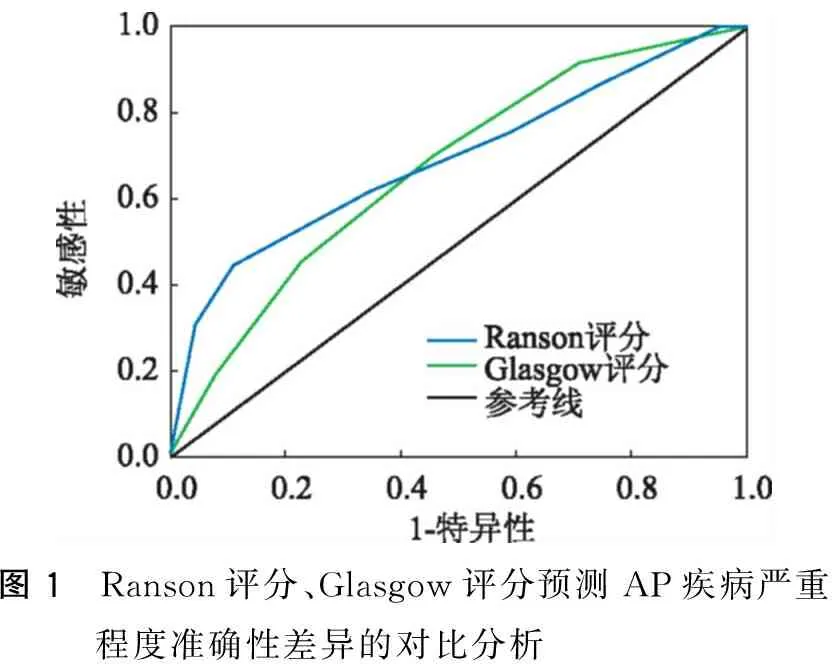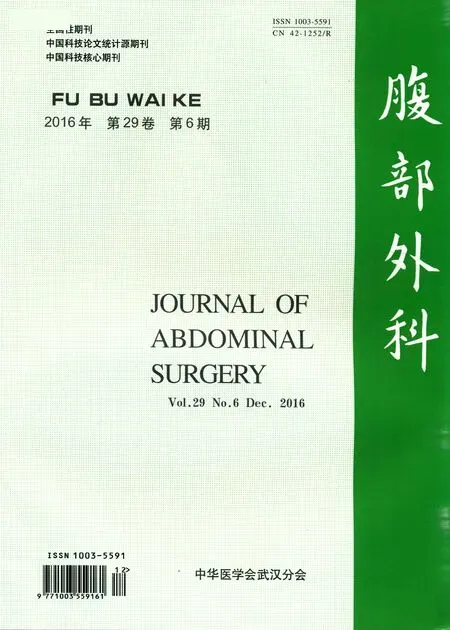Ranson评分与Glasgow评分对急性胰腺炎严重程度及预后评估的对比分析
张杨 杨琰 曹钧
Ranson评分与Glasgow评分对急性胰腺炎严重程度及预后评估的对比分析
张杨 杨琰 曹钧
目的 探讨Ranson评分与Glasgow评分对急性胰腺炎(acute pancreatitis,AP)疾病严重程度及预后预测价值的差异。方法 回顾性地收集自2014年7月至2016年7月230例AP病人的临床资料,结合中国胰腺炎诊治指南(2007)将病人分为轻症胰腺炎(mild acute pancreatitis, MAP)组、重症胰腺炎(severe acute pancreatitis,SAP)组。按照各评分系统相应评分标准对病人进行Ranson评分和Glasgow评分。比较组间病人一般临床资料及Ranson评分、Glasgow评分的差异,ROC曲线比较两评分系统对AP疾病严重程度及预后预测价值的差异。结果 MAP组与SAP组病人一般情况相比差异无统计学意义(P均>0.05),而SAP组病人Ranson评分、Glasgow评分结果相对较高,与MAP组相比差异有统计学意义(P均<0.05)。Ranson评分预测SAP的敏感性和特异性分别为61.16%和66.52%,Glasgow评分预测SAP的敏感性和特异性分别为44.40%和77.32%,两者预测SAP的曲线下面积(AUC)分别为0.69和0.67,组间差异无统计学意义(P>0.05);Ranson评分预测AP病人住院期间死亡的敏感性和特异性分别为75.00%和63.55%、Glasgow评分预测AP病人住院期间死亡的敏感性和特异性分别为62.53%和75.26%,而两者预测AP病人住院期间死亡的AUC分别为0.85和0.66,组间差异有统计学意义(P<0.05)。结论 Ranson评分在AP病人疾病严重程度和预后判断方面较Glasgow评分具有更高的稳定性和可信度,值得临床进一步研究证实。
Ranson评分; Glasgow评分; 急性胰腺炎; 预后; 预测
急性胰腺炎(acute pancreatitis,AP)是以胰腺以及全身性广泛炎症反应为主要病理生理紊乱特征的疾病之一。多数轻症急性胰腺炎(mild acute pancreatitis,MAP)病人经保守治疗可有效阻断病人病理生理紊乱过程的进展,达到临床治愈的目的,病死率相对低,预后较好;而约20%~30%的重症急性胰腺炎(severe acute pancreatitis, SAP)因合并严重的多器官功能障碍综合征(multiple organ dysfunction syndrome,MODS),病情迅速恶化、临床经过极为凶险,病死率在30%以上[1-4]。根据当前我国急性胰腺炎诊治指南及临床工作实际,SAP的判断主要依据病人临床表现及相关器官功能障碍指标。利用急性生理学与慢性健康状况评分(APACHE-Ⅱ)、Ranson及Glasgow评分等评价体系可较早实现对AP病人疾病严重程度及预后的评估,对改善SAP病人的临床结局具有重要意义。关于APACHE-Ⅱ评分对AP病人疾病严重程度及预后预测的预测价值已基本得到肯定,然限于APACHE-Ⅱ评分所涉及的临床指标相对较多,其临床应用受到一定程度的限制,而Ranson评分和Glasgow评分的评分指标则相对简便,本研究旨在探讨Ranson评分和Glasgow评分两种评分方法对AP疾病严重程度及预后预测价值的差异。
资料与方法
一、临床资料
1.病人纳入排除标准 本次研究病人的纳入标准为:新诊断的急性胰腺炎病人,发病至入院时间<72 h;排除标准为:慢性胰腺炎、慢性胰腺炎急性发作、医源性胰腺炎、外伤性胰腺炎、胰腺肿瘤及临床数据不全,不能满足本次研究要求的急性胰腺炎病人。
2.病人一般情况及分组 按照上述纳入排除标准,本次研究共收集2014年7月至2016年7月于我科就诊的AP病人230例,其中男性141例,女性89例。年龄17~88岁,平均(59.5±22.8)岁,胆源性胰腺炎127例(55.22%),酒精性胰腺炎42例(18.26%),高脂血症性胰腺炎55例(23.91%),其他原因所致急性胰腺炎6例(2.61%)。按照2007中国急性胰腺炎诊疗指南相关分级标准,本组230例病人分为MAP组199(86.52%)例,SAP组31例(13.48%)。
二、临床数据采集及治疗方法
研究开始前,分别按照Ranson评分及Glasgow评分[5-6]所涉及的相关指标设计数据采集表格,回顾性的查阅病人病历,记录病人年龄、入院时首次血常规白细胞计数、血糖、红细胞压积、碱缺失、液体补充量、丙氨酸转氨酶、天冬氨酸转氨酶、乳酸脱氢酶、尿素氮、血钙、动脉血氧分压、血浆白蛋白等指标,并对病人进行相关评分。所有病人入院后均予以禁食、胃肠减压、维持水电解质平衡、抑酸、抑酶、镇痛、营养支持,并根据病情需要选择重症监护,呼吸、循环支持及手术等治疗措施,记录病人住院期间死亡情况。
三、统计学方法

结 果
一、组间病人一般情况及Ranson评分、Glasgow评分比较
组间一般资料比较结果显示,MAP、SAP两组病人年龄分布、性别比例、病因构成3项指标相比,组间差异无统计学意义(P均>0.05);而SAP组和MAP组病人Ranson评分分别为(4.08±3.55)分和(1.35±2.01)分、Glasgow评分分别为(3.77±3.14)分和(1.34±1.65)分,结果均相对较高,组间差异有统计学意义(P均<0.05),详见表1。
二、Ranson评分、Glasgow评分预测AP疾病严重程度准确性差异的对比分析
按照中国胰腺炎诊治指南(2007)相关疾病严重程度分级标准将本组230例病人分为MAP组199(86.52%)例和SAP组31(13.48%)例。基于该分

表1 组间病人一般情况及Ranson评分、Glasgow评分比较
组结果绘制Ranson评分、Glasgow评分与AP疾病严重程度的ROC曲线,结果显示,Ranson评分预测SAP的敏感性和特异性分别为61.16%和66.52%,Glasgow评分预测SAP的敏感性和特异性分别为44.40%和77.32%,两者预测SAP的曲线下面积(AUC)分别为0.69和0.67,组间差异无统计学意义(P>0.05),详见图1。

图1 Ranson评分、Glasgow评分预测AP疾病严重程度准确性差异的对比分析
三、Ranson评分、Glasgow评分预测AP住院期间死亡情况的对比分析
本组230例病人住院期间病死8例,均为SAP组,绘制Ranson评分、Glasgow评分与病人住院期间死亡情况的ROC曲线,结果显示,Ranson评分预测AP病人住院期间死亡的敏感性和特异性分别为75.00%和63.55%、Glasgow评分预测AP病人住院期间死亡的敏感性和特异性分别为62.53%和75.26%,而两者预测AP病人住院期间死亡的AUC分别为0.85和0.66,组间差异有统计学意义(P<0.05),详见图2。
讨 论
SAP一直是临床治疗较为困难的疾病,如何实现临床对该类高危病人的早期检出、早期干预,进而达到改善SAP临床疗效及预后的最终目的,是广大学者一直以来的共同努力方向。目前,临床上判定SAP的主要参考指标是持续性的MODS。然而,临床实际工作中MODS从发生到检出难免会存在不同程度的相对滞后性,而一旦检出病人出现MODS,临床纠正则相对困难,往往不能达到理想的治疗效果,这可能是SAP病人病死率较高等不良临床结局的重要原因。因此,如何能实现早期对AP病人的疾病严重程度作出相对准确地预测,从而早期筛检出具有SAP高风险的病人群,进而早期采取相应的针对性预防、处理措施,对改善SAP病人的临床结局具有重要意义[7-9]。

图2 Ranson评分、Glasgow评分预测AP住院期间死亡情况的对比分析
查阅当前的相关研究报告,关于早期预测SAP的评价体系很多,然得到学者们认可的评价方法相对有限[10-11]。但不可否认的是,各种评价方法在AP疾病严重程度预测、并发症发生风险及不良临床结局预测方面各有所长,例如APACHE-Ⅱ评分在预测SAP病人死亡风险方面的准确性相对较高[12-13],而日本严重程度评分在预测AP病人疾病严重程度方面的可靠性相对较好[14]。由于不同评价方法的优势偏差,导致其临床应用受到制约,因此,临床迫切需要一种在疾病严重程度和预后预测方面的准确性均相对可靠的评价方法。
本研究结果显示,在AP疾病严重程度预测方面:Ranson评分预测SAP的敏感性和特异性分别为61.16%和66.52%,Glasgow评分预测SAP的敏感性和特异性分别为44.40%和77.32%,两者预测SAP的AUC分别为0.69和0.67,组间差异无统计学意义(P>0.05);而在AP病人住院期间死亡风险预测方面,Ranson评分预测AP病人住院期间死亡的敏感性和特异性分别为75.00%和63.55%,Glasgow评分预测AP病人住院期间死亡的敏感性和特异性分别为62.53%和75.26%,而两者预测AP病人住院期间死亡的AUC分别为0.85和0.66,组间差异有统计学意义(P<0.05)。基于这一结果,我们认为Ranson评分在AP病人疾病严重程度和预后判断方面较Glasgow评分具有更高的稳定性和可信度。
分析其原因,可能在于与其他评分方法相比,Ranson评分所涉及的指标涵盖范围更广,包括了病人基础状况、生命体征变化、内环境变化、血流动力学及生化指标等。而本次研究的Glasgow评分,比较突出的不足是缺少了对病人动脉血氧饱和度的观察,而血氧饱和度的变化对机体的代谢过程有着重要影响,血氧饱和度不足所致的低氧血症和酸中毒,一定程度上加剧了AP病人的炎症反应严重程度;与此同时,Glasgow评分指标之一是病人血白蛋白水平,而其早期可靠性受到质疑,因白蛋白的半衰期约为18 d左右,而本组病人的纳入标准为自发病至入院不超过72 h,因此,病人的早期病理生理变化很难通过Glasgow评分得到及时、准确的反映,这无疑大大削弱了其在AP病人疾病严重程度和预后判断上的准确性。
综上所述,我们认为,Ranson评分系统的相关指标,其涵盖的范围相对更广,指标的科学性更为可靠,在AP病人疾病严重程度和预后判断方面的准确性相对较高,与Glasgow等评分方法相比,可能具有更大的临床应用价值,然限于单中心、回顾性研究,本研究结果的可靠性和外延性仍需多中心、前瞻性研究进一步证实。
2 Vidarsdottir H,Moller PH,Vidarsdottir H,et al.Acute pancreatitis:a prospective study on incidence,etiology,and outcome.Eur J Gastroenterol Hepatol,2013,25:1068-1075.DOI:10.1097/MEG.0b013e3283640fc8.
3 Chauhan S,Forsmark CE.The difficulty in predicting outcome in acute pancreatitis.Am J Gastroenterol,2010, 105:443-445.DOI:10.1038/ajg.2009.623.
4 中华医学会消化病学分会胰腺疾病学组.中国急性胰腺炎诊治指南(2013,上海).中华消化杂志,2013,33:217-222. DOI:10.3760/cma.j.issn.0254-1432.2013.04.001.
5 Qiu L,Sun RQ,Jia RR,et al.Comparison of existing clinical scoring systems in predicting severity and prognoses of hyperlipidemic acute pancreatitis in Chinese patients:A retrospective study.Medicine,2015,94:e957.DOI:10.1097/MD.0000000000000957.
6 Ke L,Tong ZH,Li WQ,et al.Predictors of critical acute pancreatitis: a prospective cohort study.Medicine,2014,93: e108.DOI:10.1097/MD.0000000000000108.
7 Anand N,Park JH,Wu BU.Modern management of acutepancreatitis.Gastroenterol Clin North Am,2012,41:1-8. DOI:10.1016/j.gtc.2011.12.013.
8 Li J,Chen TR,Gong HL,et al.Intensive insulin therapy in severeacute pancreatitis:a meta-analysis and systematic review.WestIndian Med J,2012,61:574-579.
9 Wu BU,Johannes RS,Sun X,et al.The early prediction of mortality in acute pancreatitis: a large population-based study.Gut,2008,57:1698-1703.DOI:10.1136/gut.2008.1527.02.
10Papachristou GI,Muddana V,Yadav D,et al.Comparison of BISAP,Ranson’s, APACHE-Ⅱ and CTSI scores in predicting organ failure,complications,andmortalityinacutepancreatitis.AmJGastroenterol,2010,105:435-441.DOI:10.1038/ajg.2009.622.
11陈玉华,古赛.急性胰腺炎预后评分的进展.医学综述,2012,18:401-404.DOI:10.3969/j.issn.1006-2084.2012. 03.028.
12Gravante G,Garcea G,Ong SL,et al.Prediction of mortality in acute pancreatitis:a systematic review of the published evidence.Pancreatology,2009,9:601-614.DOI:10.1159/000212097.
13Yang CJ,Chen J,Phillips AR,et al.Predictors of severe and critical acute pancreatitis:a systematic review.Dig. Liver Dis,2014,46:446-451.DOI:10.1016/j.dld.2014.01.158.
14Park JY,Jeon TJ,Ha TH,et al.Bedside index for severity in acute pancreatitis: comparison with other scoring systems in predicting severity and organ failure.Hepatobiliary Pancreat.Dis Int,2013,12:645-650.
A comparative analysis of the predictive value difference between Ranson score and Glasgow score on disease severity and prognosis for acute pancreatitis
ZhangYang,YangYan,CaoJun.
DepartmentofGeneralSurgery,WuhanGeneralHospitaloftheGuangzhouCommand,Wuhan430070,China
Correspondingauthor:CaoJun,Email:728076459@qq.com
Objective To analyze the predictive value difference between Ranson score and Glasgow score on disease severity and prognosis for acute pancreatitis.Methods The clinical data of 230 patients with acute pancreatitis and admitted into our department from July 2014 to July 2016 were retrospectively analyzed.All the patients were divided into mild acute pancreatitis (MAP) group and severe acute pancreatitis (SAP) group according to the China guideline of diagnosis and treatment of acute pancreatitis (2007).Each patient was scored according to the scoring system of Ranson and Glasgow score system.The difference in general characteristics,Ranson score and Glasgow score was compared,and methods of ROC curve were used to analyze the predictive value difference between Ranson score and Glasgow score on disease severity and prognosis for acute pancreatitis.Results There was no significance difference in general characteristics between two groups.As compared with MAP group,Ranson score and Glasgow score in SAP group were significantly increased (P<0.05 for both).The sensitivity and specificity of Ranson score on predicting severity of AP were 61.16% and 66.52% respectively,those Glasgow score were 44.40% and 77.32% respectively,and the area under curve (AUC) for predicting severity of AP was 0.69 and 0.69 respectively.There was no significant difference between two groups (P>0.05).The sensitivity and specificity of Ranson score on predicting the deaths of AP patients during hospitalization were 75.00% and 63.55% respectively,those of Glasgow score were 62.53% and 75.26% respectively,and the area under curve (AUC) of Ranson score and Glasgow score for predicting deaths during hospitalization was 0.85 and 0.66,respectively.There were significant differences between two groups (P<0.05).Conclusions As compared with Glasgow score,Ranson score enjoys a higher stability and reliability on predicting disease severity and prognosis for acute pancreatitis.
Ranson score; Glasgow score; Acute pancreatitis; Prognosis; Prediction
·论 著·(重症急性胰腺炎专题)
430070 武汉,广州军区武汉总医院普通外科(张杨、曹钧);湖北省妇幼保健院儿童血液科(杨琰)
曹钧,Email:728076459@qq.com
R657.5+1
A [DOI] 10.3969/j.issn.1003-5591.2016.06.008
孙备,苏维宏.急性胰腺炎诊治的现状与进展.临床外科杂志,2015,23:168.
0.3969/j.issn. 1005-6483.2015.03.003.
2016-08-27)

